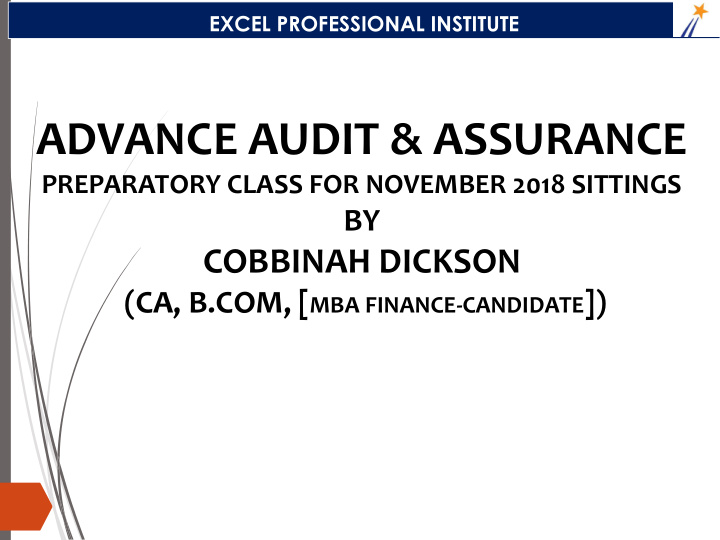



EXCEL PROFESSIONAL INSTITUTE ADVANCE AUDIT & ASSURANCE PREPARATORY CLASS FOR NOVEMBER 2018 SITTINGS BY COBBINAH DICKSON (CA, B.COM, [ MBA FINANCE-CANDIDATE ])
EXCEL PROFESSIONAL INSTITUTE EXCEL PROFESSIONAL INSTITUTE AUDIT STRATEGY
EXCEL PROFESSIONAL INSTITUTE EXCEL PROFESSIONAL INSTITUTE OUTLINE → Planning, materiality & assessing the risk of misstatement → Audit Evidence → Evaluation and Review → Group audits an Joint Audit
EXCEL PROFESSIONAL INSTITUTE EXCEL PROFESSIONAL INSTITUTE 1. Plan 2. Assess controls 3. When controls are Good, test controls and reduce substantive testing 4. When controls are bad (don’t work), perform full substantive testing 5. completion – Going concern issues 6. Report 7. Sign the report
EXCEL PROFESSIONAL INSTITUTE EXCEL PROFESSIONAL INSTITUTE 1. Planning Audit planning involves assessing materiality, audit risk, using analytical procedure, etc Audit planning involves the evaluative compliance with ethical requirement and establishing the terms of engagement as well as developing the audit strategy and developing an audit plan.
EXCEL PROFESSIONAL INSTITUTE EXCEL PROFESSIONAL INSTITUTE 2. Assessment of internal Controls – The next process is the assessment of internal controls to see if we can rely in them to protect the accuracy of the company’s account. I. If controls are good; Test controls to obtain if they actually work and if they work, reduce substantive testing. II. If the controls are bad ( don’t work), Perform full substantive test.
EXCEL PROFESSIONAL INSTITUTE EXCEL PROFESSIONAL INSTITUTE 3. What audit test will you do to check this (accounting to standard) AEIOU DADA3
EXCEL PROFESSIONAL INSTITUTE EXCEL PROFESSIONAL INSTITUTE 4. Completion Assessing going concern issues Subsequent events/events after BS 5. Report- sign
EXCEL PROFESSIONAL INSTITUTE EXCEL PROFESSIONAL INSTITUTE There are two main approaches to auditing: 1. The Audit Risk approach 2. Business Risk/Top-Down Approach
EXCEL PROFESSIONAL INSTITUTE EXCEL PROFESSIONAL INSTITUTE The Audit Risk Approach Audit risk is the risk of giving the wrong audit opinion . Primarily, it is the risk that, there are material mistakes in the financial statement and the auditor fails to detect them during substantive testing. Audit Risk= FS Risk x Detection Risk But FS Risk = Inherent Risk x Control Risk Therefore, Audit Risk = Inherent Risk x Control Risk X Detection Risk.
EXCEL PROFESSIONAL INSTITUTE EXCEL PROFESSIONAL INSTITUTE The risk of material mistake in the financial statement is called Financial Statement Risk and is made up INHERENT RISK- The risk of material mistakes occurring due to the nature of business and its business transactions. CONTROL RISK- The risk that, the inherent risks are not prevented or detected by the company’s control systems.
EXCEL PROFESSIONAL INSTITUTE EXCEL PROFESSIONAL INSTITUTE The auditor assess Financial Statement Risk by Assessing the inherent risks Assessing the control risks I. Do the controls look good? II. Are they actually operating properly? (Control test) If the financial statement risk is HIGH, then the auditor needs to keep Detection Risk LOW, by increasing the substantive tests, sending a more experienced audit team.
EXCEL PROFESSIONAL INSTITUTE EXCEL PROFESSIONAL INSTITUTE Problems with the Audit Risk Approach There is a heavy focus on details I. This could result in missing bigger issues – major fraud, ML or problems with going concern. II. Detailed tests are likely to be done by relatively junior staff …… meaning , a. Less chance of spotting big issues due to lack of experience b. Difficult to give clients “added value” . The approach was time consuming, and was not making use of advances in IT.
EXCEL PROFESSIONAL INSTITUTE EXCEL PROFESSIONAL INSTITUTE Business Risk /Top-Down Approach The business Risk /Top-Down approach starts by considering risks to the business itself. This is necessarily going to focus on high level issues likely to concerned investors. Once the business risks are identified; The auditor can consider how these business risks are likely to create financial statements risks Audit work can then be directed at these financial statement risks. The auditor can add value to the client by suggesting how business could be managed
EXCEL PROFESSIONAL INSTITUTE EXCEL PROFESSIONAL INSTITUTE 1. Audit work part of the syllabus - usually a stand-alone questions or associated with Audit Risks. 2. Typically you will be presented with 2 or 3 questions/different stories and your job is to identify the issues that auditor might consider and then suggest the audit procedures or the audit evidence that should be available to deal with the issues. 3. It is virtually guaranteed to get this on the exams either as part of audit risks question or stand-alone questions.
EXCEL PROFESSIONAL INSTITUTE EXCEL PROFESSIONAL INSTITUTE 4. MATTERS TO CONSIDER This section of the syllabus requires 2 things: A thorough knowledge of the accounting standards, so that, accounting issues can be identified from a scenario in the exam. The ability to suggest audit procedures to address those accounting issues.
EXCEL PROFESSIONAL INSTITUTE EXCEL PROFESSIONAL INSTITUTE QUESTION TECHNIQUES. 1)Accounting Matters: If a question asks for MATTERS, the main issues are: a) What is the correct accounting treatment in this situation? b) Is the company’s accounting treatment correct or not? c) How material are the mistakes they are making?
Thank You! Questions, Comments. etc.
Recommend
More recommend